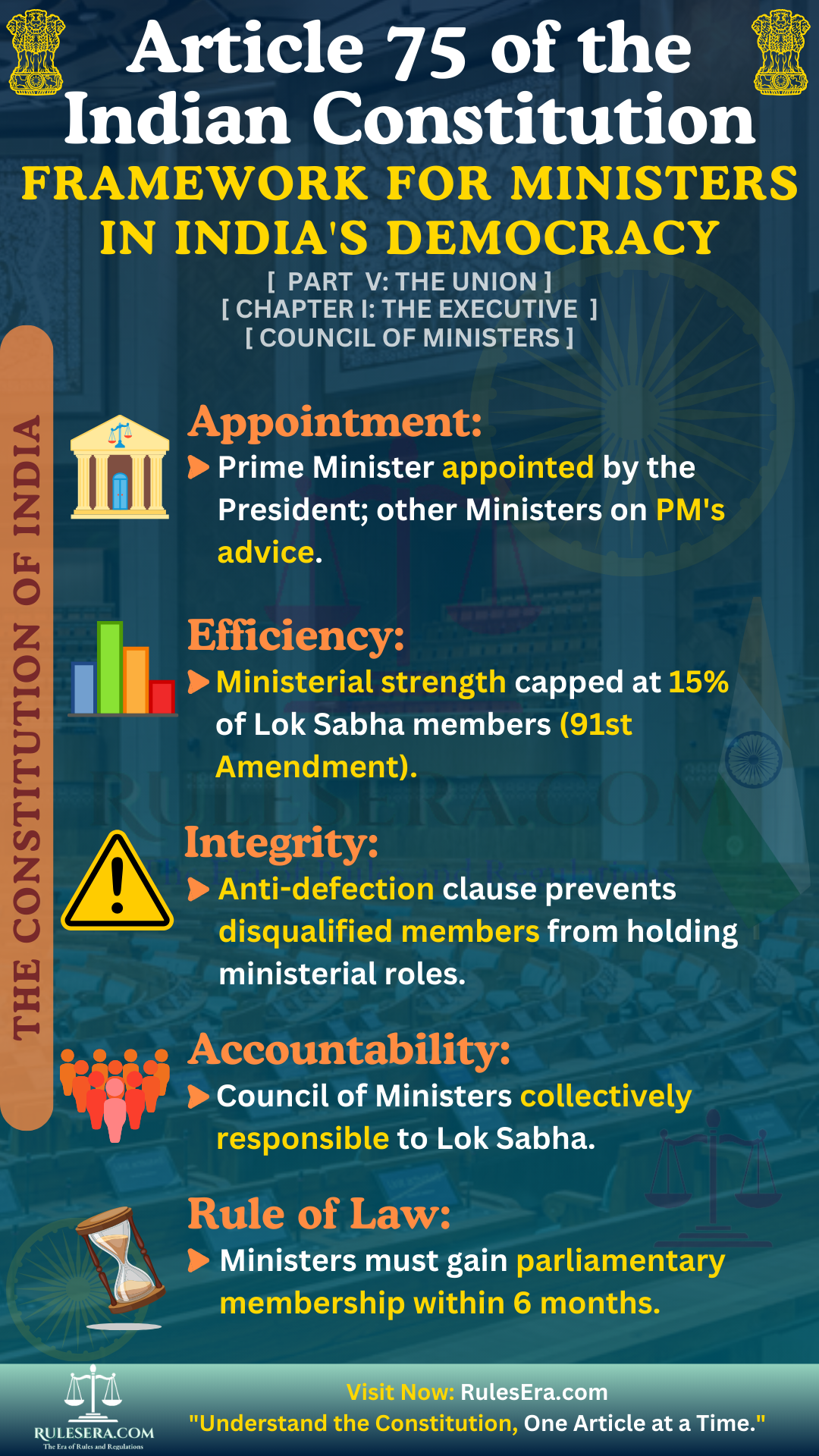Part V: The Union
Chapter I: The Executive
Article 75: Other Provisions as to Ministers

--- Original Article ---
Article 75 outlines the framework governing the appointment, responsibilities, and terms of office for the Council of Ministers, led by the Prime Minister. It ensures a clear separation of powers and establishes the accountability of the executive branch to the Parliament.
Clause-by-Clause Analysis:
Clause (1): Appointment of the Prime Minister and Ministers
The Prime Minister is appointed by the President, while other Ministers are appointed on the Prime Minister’s advice. This reflects the President’s role as a constitutional head and reinforces democratic principles in the appointment process.
Clause (1A): Limit on Number of Ministers
91st Amendment (2003) limits the size of the Council of Ministers to fifteen percent of the total members of the Lok Sabha, preventing excessive ministerial appointments.
Clause (1B): Disqualification for Ministerial Appointment
Introduced by the 91st Amendment, it disqualifies members disqualified under the Tenth Schedule from becoming Ministers, ensuring integrity among representatives.
Clause (2): Ministers’ Tenure
Ministers serve at the pleasure of the President, reflecting executive oversight by the constitutional head.
Clause (3): Collective Responsibility
The Council of Ministers is collectively responsible to the Lok Sabha, reinforcing parliamentary accountability.
Clause (4): Oaths of Office and Secrecy
Ministers must take oaths of office and secrecy, administered by the President, as per the Third Schedule.
Clause (5): Six-Month Rule
Ministers not elected to Parliament must become members within six months or they cease to be Ministers.
Clause (6): Salaries and Allowances
The salaries and allowances of Ministers are determined by Parliament, as specified in the Second Schedule.
Amendments and Historical Significance:
The 91st Amendment (2003) significantly shaped Article 75 by limiting ministerial appointments and disqualifying defectors. This helped curb oversized ministerial councils and political instability caused by defections.
Real-Life Examples:
The anti-defection clause under Clause (1B) played a key role in preventing disqualified members from becoming Ministers in coalition governments.
Legislative History:
Article 75, originally drafted as Draft Article 62, was debated on December 30 and 31, 1948, and October 14 and 17, 1949. These sessions led to several key amendments that refined the final text.
Debates and Deliberations:
Kazi Syed Karimuddin proposed an amendment to protect ministers from arbitrary removal, suggesting they should only be dismissed on serious grounds. He aimed to shield ministers from undue pressures.
Prof. K. T. Shah suggested the Prime Minister be chosen from the majority party, to align with collective responsibility, while also advocating for business interest disclosures by ministers.
Dr. B.R. Ambedkar disagreed with the proposals, stating the Prime Minister should have discretion in appointments, with Parliament’s oversight ensuring accountability.
In the end, the Assembly incorporated these principles without the proposed amendments, maintaining the balance of powers envisioned by the Constitution.